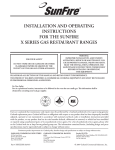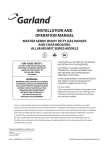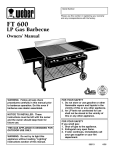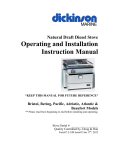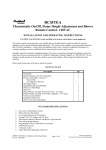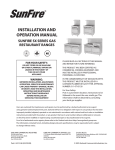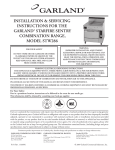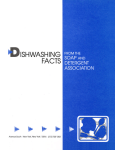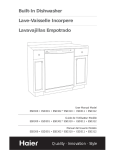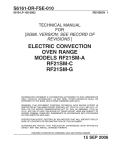Download Service Manual
Transcript
Service Manual Master Gas Production Griddles models CG-24, CG-36, CG-48, CG-60, CG-72 FOR YOUR SAFETY: DO NOT STORE OR USE GASOLINE OR OTHER FLAMMABLE VAPORS OR LIQUIDS IN THE VICINITY OF THIS OR ANY OTHER APPLIANCE WARNING: IMPROPER INSTALLATION, ADJUSTMENT, ALTERATION, SERVICE OR MAINTENANCE CAN CAUSE PROPERTY DAMAGE, INJURY, OR DEATH. READ THE INSTALLATION, OPERATING AND MAINTENANCE INSTRUCTIONS THOROUGHLY BEFORE INSTALLING OR SERVICING THIS EQUIPMENT PLEASE READ ALL SECTIONS OF THIS MANUAL AND RETAIN FOR FUTURE REFERENCE. THIS PRODUCT HAS BEEN CERTIFIED AS COMMERCIAL COOKING EQUIPMENT AND MUST BE INSTALLED BY PROFESSIONAL PERSONNEL AS SPECIFIED. IN THE COMMONWEALTH OF MASSACHUSETTS THIS PRODUCT MUST BE INSTALLED BY A LICENSED PLUMBER OR GAS FITTER. APPROVAL NUMBER: G-1-07-05-28 For Your Safety: Post in a prominent location, instructions to be followed in the event the user smells gas. This information shall be obtained by consulting your local gas supplier. Users are cautioned that maintenance and repairs must be performed by a Garland authorized service agent using genuine Garland replacement parts. Garland will have no obligation with respect to any product that has been improperly installed, adjusted, operated or not maintained in accordance with national and local codes or installation instructions provided with the product, or any product that has its serial number defaced, obliterated or removed, or which has been modified or repaired using unauthorized parts or by unauthorized service agents. For a list of authorized service agents, please refer to the Garland web site at http://www.garland-group.com. The information contained herein, (including design and parts specifications), may be superseded and is subject to change without notice. Garland Commercial Ranges, Ltd. 1177 Kamato Road Mississauga, Ontario L4W 1X4 Canada P: 905 624 0260 F: 905 624 5669 www.Garland-Group.com Parts & Service 1 800 427 6668 (Phone, US & Canada) 1 800 361 7745 (Fax, US & Canada) G_GC_SM_CHAINGRIDDLE_GCGTRAINING06 (03/19/13) (03/19/13) G_GC_SM_CHAINGRIDDLE_GCGTRAINING06 © 2013 Garland Commercial Ranges, Ltd.1 Page IMPORTANT INFORMATION WARNING: This product contains chemicals known to the state of California to cause cancer and/or birth defects or other reproductive harm. Installation and servicing of this product could expose you to airborne particles of glass wool/ceramic fibers. Inhalation of airborne particles of glass wool/ceramic fibers is known to the state of California to cause cancer. Operation of this product could expose you to carbon monoxide if not adjusted properly. Inhalation of carbon monoxide is known to the state of California to cause birth defects or other reproductive harm. Keep appliance area free and clear of combustibles. Page 2 G_GC_SM_CHAINGRIDDLE_GCGTRAINING06 (03/19/13) TABLE OF CONTENTS IMPORTANT INFORMATION. . . . . . . . . . . . . . . . . . . . . . . . . . . . . . . . . . . . . . . . . . 2 DIMENSIONS AND SPECIFICATIONS . . . . . . . . . . . . . . . . . . . . . . . . . . . . . . . . . . 4 WHAT IS A CHAIN GRIDDLE . . . . . . . . . . . . . . . . . . . . . . . . . . . . . . . . . . . . . . . . . . 5 How Does it work? . . . . . . . . . . . . . . . . . . . . . . . . . . . . . . . . . . . . . . . . . . . . . . . . . . . . . . . . . . . . . . .5 INSTALLATION . . . . . . . . . . . . . . . . . . . . . . . . . . . . . . . . . . . . . . . . . . . . . . . . . . . . . . 6 Mechanical . . . . . . . . . . . . . . . . . . . . . . . . . . . . . . . . . . . . . . . . . . . . . . . . . . . . . . . . . . . . . . . . . . . . . .6 Gas Supply . . . . . . . . . . . . . . . . . . . . . . . . . . . . . . . . . . . . . . . . . . . . . . . . . . . . . . . . . . . . . . . . . . . . . .6 Electrical Power, Lighting & Control . . . . . . . . . . . . . . . . . . . . . . . . . . . . . . . . . . . . . . . . . . . . . . .7 Ventilation . . . . . . . . . . . . . . . . . . . . . . . . . . . . . . . . . . . . . . . . . . . . . . . . . . . . . . . . . . . . . . . . . . . . . . .7 Start-Up . . . . . . . . . . . . . . . . . . . . . . . . . . . . . . . . . . . . . . . . . . . . . . . . . . . . . . . . . . . . . . . . . . . . . . . . .7 OPERATION & MAINTENANCE. . . . . . . . . . . . . . . . . . . . . . . . . . . . . . . . . . . . . . . . 8 Cleaning. . . . . . . . . . . . . . . . . . . . . . . . . . . . . . . . . . . . . . . . . . . . . . . . . . . . . . . . . . . . . . . . . . . . . . . . .8 SERVICING. . . . . . . . . . . . . . . . . . . . . . . . . . . . . . . . . . . . . . . . . . . . . . . . . . . . . . . . . . 9 Have The Right Tools And Instruments . . . . . . . . . . . . . . . . . . . . . . . . . . . . . . . . . . . . . . . . . . . .9 Adjustments . . . . . . . . . . . . . . . . . . . . . . . . . . . . . . . . . . . . . . . . . . . . . . . . . . . . . . . . . . . . . . . . . . . . .9 Pilot Flame Adjustment . . . . . . . . . . . . . . . . . . . . . . . . . . . . . . . . . . . . . . . . . . . . . . . . . . . . . . . . . .9 Burner Air . . . . . . . . . . . . . . . . . . . . . . . . . . . . . . . . . . . . . . . . . . . . . . . . . . . . . . . . . . . . . . . . . . . . . . .9 Removing the Griddle Plate . . . . . . . . . . . . . . . . . . . . . . . . . . . . . . . . . . . . . . . . . . . . . . . . . . . . . .9 Thermostat . . . . . . . . . . . . . . . . . . . . . . . . . . . . . . . . . . . . . . . . . . . . . . . . . . . . . . . . . . . . . . . . . . . . .10 Thermocouple . . . . . . . . . . . . . . . . . . . . . . . . . . . . . . . . . . . . . . . . . . . . . . . . . . . . . . . . . . . . . . . . . .10 How To Replace A Thermocouple . . . . . . . . . . . . . . . . . . . . . . . . . . . . . . . . . . . . . . . . . . . . . . . .10 Incandescent Lamps . . . . . . . . . . . . . . . . . . . . . . . . . . . . . . . . . . . . . . . . . . . . . . . . . . . . . . . . . . . . 11 Pilot Ignition Control (Control Module) . . . . . . . . . . . . . . . . . . . . . . . . . . . . . . . . . . . . . . . . . . . 11 Gas Valve Regulator . . . . . . . . . . . . . . . . . . . . . . . . . . . . . . . . . . . . . . . . . . . . . . . . . . . . . . . . . . . . .12 Power Switches . . . . . . . . . . . . . . . . . . . . . . . . . . . . . . . . . . . . . . . . . . . . . . . . . . . . . . . . . . . . . . . . .12 Control Circuit . . . . . . . . . . . . . . . . . . . . . . . . . . . . . . . . . . . . . . . . . . . . . . . . . . . . . . . . . . . . . . . . . .12 CONTROL PANEL SCHEMATIC DIAGRAM . . . . . . . . . . . . . . . . . . . . . . . . . . . . . 13 SERVICE BULLETIN #95-5 . . . . . . . . . . . . . . . . . . . . . . . . . . . . . . . . . . . . . . . . . . . 14 Revision History (CG Griddles) . . . . . . . . . . . . . . . . . . . . . . . . . . . . . . . . . . . . . . 18 G_GC_SM_CHAINGRIDDLE_GCGTRAINING06 (03/19/13) Page 3 DIMENSIONS AND SPECIFICATIONS Combustible Wall Clearances Electrical Requirements Sides: 6” (152mm) Manifold Pressure Required After Built-in Regulator Back: 6” (152mm) Natural: 3.5" W.C. (8.75mbar) 120 V, Single Phase, 60Hz, 1 A 6’ (1829mm) power supply cord provided. IMPORTANT: Minimum Supply Pressure Required: Specifications: Propane: 10" W.C. (25mbar) NOTE: No cord and plug on export units Unit must be installed on legs for proper air circulation. Natural: 7" W.C. (17.4mbar) Propane: 11" W.C. (27.4mbar) Export Voltages: Ventilation NOTE Commercial cooking equipment requires an adequate ventilation system. Gas Input Ratings shown are for installations up to 2,000 feet (610mm) above sea level. BTU input ratings must be derated for high altitude installations. Refer to the National Fire Protection Association’s standard NFPA96. Direct connection on junction box. NOTE: Export voltages are available on request. 220-240 V, 50 Hz, 0.4 A, Single Phase. 0.625 16 5.75 146 3" [76mm] Extended Bumper to Prevent Flue Vent Blockage 2.5 84 Cooking Surface Electric Cord/Connection Gas Connection Rear Gas Inlet 10 254 3.25 83 Grease Trough Gas Connection Centered On Unit Width [Left to Right] 20 508 35 889 24 38.75 610 984 Electric Cord/Connection Inches mm DIMENSIONS: Available in 24, 36, 48, 60 & 72 Widths 610, 914, 1219, 1524 & 1829 5.5 140 4.75 121 15 381 Optional Stand Counter Removable Leg Grease Drawer 27 686 15.75 400 6 Counter 152 Finished 10 Floor 254 6 152 SIDE VIEW 1.5 38 5 127 PLAN VIEW [Model CG-48R] Dimensions - All Models INPUT CHART - Natural Or Propane Gas Grease Drawer(s) 2' & 3' Units - One 4', 5' & 6' Units - Two Finished Floor Optional Stand Shipping Weight Model Number BTU/ hour kW Gas Inlet CG-24R 60,000 17.60 3/4" 335/152 CG-36R 90,000 26.40 3/4" 485/220 CG-48R 120,000 35.00 3/4" 625/284 CG-60R 150,000 44.00 3/4" 765/348 CG-72R 180,000 52.70 1" 995/411 lb./kg. FRONT VIEW [Model CG-48R] Page 4 G_GC_SM_CHAINGRIDDLE_GCGTRAINING06 (03/19/13) WHAT IS A CHAIN GRIDDLE Commercial chain restaurants impose strict food procedures on franchise owners and operators to guarantee the quality and consistency of the product. Beef burgers, hamburgers, french fries, onion rings, fried chicken and tortillas for example, must meet rigid standards of quality involving the ingredients used, the recipes followed, storage and, not least, the cooking temperature and time of cooking. Figure 1 -Front view of counter-top chain griddle Accuracy of temperature control and the heating stability of the cooking surface are essential in maintaining consistent quality in the product. Control and stability are the two primary features in the new chain griddle. As compared with previous gas griddles of the same kind, temperature control of heating zones in the chain griddle is far tighter and more precise. Main power ON green indicator light Two features provide precision control. One feature is a burner for every foot of griddle surface. The other is that each burner is electronically monitored for temperature control. As a result, at 30,000 BTU using natural gas, there is excellent energy management and power recovery. How Does it work? Temperature sensors are embedded in the griddle plate. Each sensor is close to the plate surface where the load is. The effect of this arrangement is to achieve an even temperature gradient across the plate. Thanks to the electronic monitoring feature, a much faster response to changes in surface temperature is achievable in the chain griddle than in previous units. The smoother temperature gradient per unit surface area and accurate temperature control has made the chain griddle an instant success. This simple explanation of the two main features of the unit is what makes it so special. Without fast response and a smooth gradient, the chain griddle would be just another design among many. Explaining why the unit is special is one thing and understanding how it works in another. Service technicians need to know this to have complete confidence when servicing the unit. We describe how it works in the next part of this section. G_GC_SM_CHAINGRIDDLE_GCGTRAINING06 (03/19/13) Burner ON amber indicator light Air vents Flame Securing Pilot ON green viewport fasteners indicator light for removable Removable top Zone top access panel thermostat access panel Main power switch Hinged drop-down bottom half access panel Zone power Leg of counter-top switch style griddle Grease tray When the main power switch is turned on, the power indicating lamp is illuminated and power is applied to the thermostat input of the ignition modules. This will initiate the pilot ignition sequence. The ignition module supplies a spark ignition at the pilot burner and will energize the pilot solenoid valve for a maximum trail period of 50 seconds. If the pilot flame ignites and is sensed within the 50 second period, the main burner output of the ignition module will be energized. The pilot indicating lamp will illuminate. The main burner solenoid valves are then controlled by the thermostats. As a thermostat calls for heat, it will energize its output and the main burner valve along with the burner indicating lamp will energize. The main burner will cycle with the thermostat. There is only one trial for ignition. If the pilot flame is not sensed during the trail period, the ignition module will lock out. All ignition module outputs will be de-energized. To reset the ignition module the main power switch must be turned off for a period of 30 seconds. Page 5 WHAT IS A CHAIN GRIDDLE continued During normal operation, the pilot flame is continually monitored. The flame current signal must maintain 0.15 microamps minimum. Flame failure response time is 0.8 seconds maximum. If at any time the ignition module does not detect a pilot flame, it will repeat the ignition process by allowing a 50 second trial of ignition. Figure 2 – Sequence of Operation Power Spark o/p Ignition Flame sensor Pilot valve Figure 2 illustrates this sequence of operation. Main valve INSTALLATION The instructions given for installation form part of the delivery package. Anyone installing a chain griddle should follow a strict procedure to make sure installation and commission are safe, efficient and complies with the applicable local codes. Here is a check list of things to do in the order we recommend. CAUTION : Check the pipe capacity tables given in the installation code. When a long supply pipe run is necessary, you may have to install a supply line lager than 3/4” • Have a qualified gas technician check the gas supply to make sure it will deliver the BTUs of gas the unit requires to operate with no more than 1/2” water pressure drop. Also when making this check be certain that all equipment on the gas line is turned to the ON position. • If you are installing the unit using a new gas installation, make sure the supply lines have been cleaned and purged of piping compound, chips and other debris. Mechanical • • Uncrate and check for shipping damage both obvious and hidden. Write a damage report and report immediately to the carrier. Check the serial plate behind the front panel. To do this, remove the front panel by unscrewing the two screws in the upper right and left corners. Next unscrew the two fasteners securing the hinged lower font panel in place. Note the burner inputs shown on the serial number plate. It may be necessary to refer to these later. You also need to be certain of the type of gas to which the unit is connected. The serial plate also specifies the type of gas required for the unit. Also, check that the electrical connections are in good order. NOTE : The chain griddle is certified for installation on a combustible base with minimum clearance of 6” (152mm) back and 6” (152mm) sides from combustible walls. • Every unit is fitted with a readily accessible shut-off valve at the main manifold. Use a minimum of 3/4” NPT pipe to connect the incoming gas supply. Page 6 WARNING : Use soap solution if you have to check the gas lines for leaks. • Place and install the unit on the legs or caters provided, and make sure there is a minimum of 4” (102mm) air space below the unit for adequate air flow to the burners. CAUTION: Check for obstructions or objects that could restrict the air flow to the burners. • Using a spirit level variously across the front, rear and sides of the unit, level it by adjusting the leveling legs. Gas Supply NOTE : For efficient operation, the griddle plate must be level. G_GC_SM_CHAINGRIDDLE_GCGTRAINING06 (03/19/13) INSTALLATION continued • • • Each thermostat controls one zone burner though a dual solenoid-pressure regulator valve complete with a pressure test spigot. Check the manifold gas pressure on each combination valve to make sure it is the same as that shown on the serial plate. The gas pressure should be 3.5” WC for natural gas and 10.0” for propane gas. For access to the pressure test spigots, turn the main power switch and all zone power switches to the OFF position and lower the front panel on its hinge. This is a safety precaution. The test spigots are at the rear of the rear of the combination regulator valves. Connect your manometer to the first valve for test and turn the manual shut-off valve to the ON position. NOTE : The shut off valve is under the unit. When it is ON and in the open position, the valve position is in line with the piping. Also, see the electrical procedure below for notes on the status indictor lights and setting the thermostats. • Turn the main power switch and the zone power switches to the ON position. • Set all the thermostat dials to 350˚F. When all the burners are operating, check and record the manometer reading, which should be the same manifold pressure as that specified on the serial plate (3.5” WC for natural gas and 10.0” for propane gas). Adjust the regulator to obtain the pressure rate specified. • When satisfied with the reading obtained, turn the main power switch OFF. Remove the manometer test tube and re-cap the test spigot. • Repeat this operation on each combination regulator valve to correctly set it. Then turn each thermostat, zone and main power switch OFF. Electrical Power, Lighting & Control WARNING : Do not work on ungrounded equipment. It is dangerous. • National and local electrical codes require that all devices of this type be electrically grounded. Check to make sure the unit is grounded. CAUTION : Make sure the electrical connections enclosed by the panels are in good order and undamaged before closing and securing the front panels. • To check the unit lighting, turn the main power switch of the unit to the ON position. The green light of the power switch and the green indictor of the gas pilot of each section of the griddle should illuminate. CAUTION : If after two minutes the pilot ignition fails, turn the main power switch OFF. Wait five minutes and switch the main power ON again. • When the green indicator for each zone is illuminated, turn the zone power switch for each zone ON. The thermostats can now be set to the desired temperature. • The amber light burner indicator cycles with the operation of the thermostat. Ventilation For efficient operation this unit requires a minimum ventilation air supply of 50frm. The ideal method of ventilation is a well-designed canopy of hood that exceeds 6” (152mm) beyond all sides of the unit. Ideally, the bottom of the hood should be set 6’6” (1981mm) from the floor. Gas burners and pilot devices need a sufficient air supply to operate efficiently, so do not place large objects anywhere near them to restrict or in any way limit the air flow. In most operations, the chain griddle will be used in conjunction with other kitchen equipment. The need for the ingress of air to the kitchen area must be sufficient to compensate for the air the ventilation system abstracts. Unless the air flow is sufficient a subnormal, and probable negative, atmospheric pressure will result, which will adversely affect the operation of the equipment and make work in the kitchen area unpleasant. Start-Up When the chain griddle is used for the first time, the griddle top requires seasoning. To season a griddle surface, follow this procedure. 1. Wash the griddle surface with a hot, mild detergent or soap solution, then rinse and dry thoroughly. 2. Set the thermostat to 175˚F for 30 minutes, then apply a film of cooking oil to the cooking surface and wipe away the excess. 3. After (5) five minutes, wipe the griddle plate clean. NOTE : This griddle is equipped with a 3-pronged plug cord set to fit any 120V AC3-prong, 15 amp-rated, grounded receptacle. G_GC_SM_CHAINGRIDDLE_GCGTRAINING06 (03/19/13) Page 7 INSTALLATION continued 4. Re-set the thermostat to 275°F and apply a second film of oil. After (5) five minutes, wipe off the excess oil. 5. Reset the thermostat to the cooking temperature and apply a final film of oil. After (3) minutes, wipe off the excess oil. The griddle is now seasoned and ready for use. NOTE : We recommend reseasoning the griddle before each day’s operations begin. Franchise operators who follow explicit operating procedures should be made aware of this recommendation. OPERATION & MAINTENANCE During idle periods, reduce the thermostat settings to conserve energy. A setting of 175°F to 200˚F is enough to keep the plate warm. Reducing the temperature also reduces the load on the thermostat. 1. At then end of the operations, turn the power and zone switches OFF. There is no need to change the thermostat settings when the unit is not in use. 2. Don’t overheat the griddle. Excessive heat causes grease to carbonize and makes the surfaces hard to clean. 3. For a more thorough cleaning, use Garland Ranges F69 fryer and griddle cleaner. Polish the plate to a bright finish, then wash, rinse and thoroughly dry it. 4. Follow the procedure specified (see Start-Up) to reseason the cooking surface. 5. To clean the exterior surface of a chain griddle, clean the stainless steel with a hot detergent or soap solution. Remove baked on grease by applying the cleanser in the direction of the polishing lines of the stainless steel surface. 3. Empty the grease trays often to avoid spillovers. 4. For extended shutdown or major maintenance, turn the power and zone switches OFF, close the manual shut-off gas valve, and unplug the electrical power cord. Cleaning 1. At the end of the cooking operations, wipe and clean the unit while it is still warm. Use a spatula to remove food residue and burnt grease. 2. When the plate is cool, wash it with a mild detergent, dry it, and wipe it with a slightly oiled cloth. Page 8 CAUTION : Do not rub stainless steel in a circular motion. This destroys the finished surface of the metal and detracts from its appearance. If it is necessary to remove hard and burnt on deposits from high quality surfaces, use SCOTCH-BRITE or STAINLESS scouring pads by running with the grain of the finished steel. Remove heat tint the same way, using if necessary a non-abrasive powered cleanser with the SCOTCH-BRITE or STAINLESS pad. On no account use ordinary steel wool, it will damage the finished surface. G_GC_SM_CHAINGRIDDLE_GCGTRAINING06 (03/19/13) SERVICING Many factors affect the serviceability of equipment. In the chain griddle, there are more components to service than in older models. The new griddle is a compact design. Access to the temperature control circuitry and ignition units is easy. Service techniques for the thermocouple will vary depending on the model type. They unit is available with a 6” (152mm) leg which means that under the griddle plate there is only 6” (152mm) of working room. To replace a thermocouple it is difficult to lift the griddle plate, firmly secured to the support frame. To replace a thermocouple requires bottom access because the plate is securely fixed (see Figure 3). With this introduction to serviceability, and apart from the features that make the chain griddle superior to more conventional units, many of the servicing tasks are standard; the adjustments likewise. The procedures that follow are a plain guide to servicing, beginning with adjustments to various components. Have The Right Tools And Instruments In addition to a service technician’s normal hand tools, for servicing this chain griddle we recommend: 1. A manometer or other suitable instrument for measuring gas pressure 2. A multimeter 3. A digital read-out temperature meter 4 A micro-ammeter CAUTION : In this chain griddle we use a J-type thermocouple, which requires a meter with a J-type connection for checking. Most meters have K-type connections. 1. To remove the upper front and lower front panels, refer to the installation procedure given earlier. 2. To reduce the volume of gas feed to the pilot, turn the small screw in the pilot adjusting valve clockwise. 3. To increase the gas feed to the pilot, turn the same screw counter-clockwise. NOTE : Adjust the gas feed to produce a 7/16” (11mm) long flame to make sure the flame envelopes the top of the flame sensor. Burner Air Make sure a burner is warm before adjusting the air shutters and follow this procedure. 1. First, loosen the screw along the side of the burner near the orifice. 2. A burner flame that gets too much air appears to lift above the burner as though separated from it. This means the shutter needs throttling back to a more closed position. 3. A yellow tip on the flame is a sign that the shutter is not passing enough air to feed the flame. In this case, it necessary to open the shutter. 4. When the shutter adjustment is complete, tighten the screw to lock the shutter setting in the adjusted position. 5. Re-close the upper and lower front panels and replace the fasteners. Removing the Griddle Plate If it is necessary to remove the griddle top, follow this procedure: Adjustments 1. Disconnect the power supply. Every griddle is inspected and tested before it leaves the factory. Adjustments to the unit during installation and servicing are the responsibility of the field operator and are not considered to be defects in material or workmanship. For this reason, adjustments are not covered under the equipment warranty. 2. Remove the upper control panel. Pilot Flame Adjustment 5. Remove the griddle top retaining bolts (both left and right). A pilot adjustment valve is in the line form each pilot combination valve and access to it is behind the lower front panel. G_GC_SM_CHAINGRIDDLE_GCGTRAINING06 (03/19/13) 3. Open the lower control panel. 4. Disconnect all thermocouple sensors and shield bayonet adapters. (To reassemble, see the Thermocouple section.) 6. Remove the back flue. 7. The griddle top is now easily removed. Page 9 SERVICING continued Thermostat Make sure the thermostat knob is correctly aligned with the dial indicator. To align the knob with the graduated dial correctly, follow this procedure. 1. Turn the knob and shaft fully counter-clockwise. Loosen the set screw in the knob and align the pointer with the first line of the scale at the lower left position. NOTE : When the knob is fully rotated clockwise, the pointer should align with the last line of the scale. 2. Set the dial to 350˚F. Wait at least three cycles before monitoring the temperature. 3. Use a surface temperature probe disc positioned on the center line with the thermostat knob and centered front to back on the griddle plate. The thermostat will overshoot and undershoot as caused by the lag time in the thermal response of the heat sourceto-plate and plate-to-sensor. The calibration temperature will be the mid-point between the minimum and maximum readings. Other than the alignment of the knob pointer, there is no means to calibrate the thermostat. It has been precisely calibrated by the manufacturer. Thermocouple If the temperature is incorrect check the thermocouple. The thermocouple in this unit is a Type J, which requires the use of a J-type temperature meter for checking. For a complete understanding of the thermocouple used in the chain griddle see the GCR Service Bulletin #95-5 entitled “Thermocouples”. A thermocouple is an accurate temperature measuring device that consists of two dissimilar conductors joined together at their ends. It works on a simple principle, which is that the thermoelectric voltage between the two junctions is proportional to the temperature difference between them. This principle is applied to measure the temperature at one of the junctions when the other is held at a fixed known temperature. The technology is not new, but its use in GCR griddles is recent. The thermocouple probe is embedded in the griddle plate and accurately registers the surface temperature. It is a reliable device, but can cause problems when it fails for any reason. In addition to deterioration from aging, it can fail in two ways: one from an open-circuit (that is, a break in one of its wired); the other when it short-circuits. Page 10 If a thermocouple open circuits, the thermostat will shut off and prevent the gas valve from opening, which means the burner will not function. If a unit short circuits somewhere behind the junction, it creates a new junction and because the circuit cannot detect the existence of a short circuit fault, there is a dramatic increase in temperature. The thermocouple detects changes in temperature, but because of the short circuit it may fail to register the set temperature at the thermostat. This means the burner may not shut off. At the other extreme, the short circuit may occur in a place not shielded from the flue gases, which means the burner may shut off prematurely. These are the two conditions to look for in a shorted thermocouple. Deterioration from aging and from welding dissimilar metals together to for a junction introduces a contaminant that causes mechanical stress. Over time, five to ten years, metal fatigue from aging is certain. As a result, the temperature curve will vary. How To Replace A Thermocouple A heat shield protects the thermocouple from the burner flames and flue gases. Without the shield, the thermocouple would register flame heat to the thermostat instead of sensing the temperature of the griddle plate. To replace a thermocouple (refer to Figure 3), following this procedure: 1. Open the front panel to get access to the terminal board. 2. To withdraw the thermocouple, first remove the heat shield. It is held in place by two combination Philip and Robinson-heat size number 10 sheet metal screws. Remove the heat shield by sliding it down the wire. 3. A bayonet connector secures the thermocouple in place. Reach inside the hole and push and twist the bayonet connector a quarter turn. 4. Remove the connection to the terminal board and feed these wires through the heat shield. The thermocouple is now removed. 5. Connect the wires of the replacement thermocouple, but make sure the polarity is correct. Connect the negative red wires to terminal 7 on the thermostat and the positive white wire to terminal 8. (See schematic diagram). 6. Thread the thermocouple through the heat shield and into the plate cavity. G_GC_SM_CHAINGRIDDLE_GCGTRAINING06 (03/19/13) SERVICING continued Figure 3 – Replacing a thermocouple Bayonet adapter Adjust to about 4.5" before installing Griddle plate About 1" before compression Probe heat shield assembly 7. The bayonet connector is spring loaded. Turn the connector so that it makes good contact with its seat on the plate, and adjust the spring so that at least 1” (25mm) of spring is available to push home. This is, it is loaded 1” (25mm) from the bayonet adapter. 8. Once this adjustment is made, remove the thermocouple from its cavity, pry the old heat sink material from the cavity and apply fresh heat sink compound (Garland Commercial Ranges part #77024). 9. Re-assemble the unit. Incandescent Lamps These lamps, similar in construction if not in shape to ordinary incandescent light bulbs, sometimes fail because of metallurgical breakdown of the light filament material. The green status light (PL1) should illuminate when the main switch SW1 is closed. G_GC_SM_CHAINGRIDDLE_GCGTRAINING06 (03/19/13) • If PL1 doesn’t illuminate when SW1 is closed, replace it. • Failure of the amber lights (PL3, PL4, etc.) monitoring the zones cycle with the thermostat is not easy to detect. When on, an amber zone light is working. If it does not appear to light as part of the ‘burner on’ cycle, check. If the thermostat cycles the burner to be on, the PL amber light should illuminate. Pilot Ignition Control (Control Module) The Johnson G770 pilot ignition unit will lock out if the pilot flame is not sensed before the end of the ignition trial period and has to be reset. • To reset the ignition control, turn off the thermostat for a minimum of 30 seconds. Page 11 SERVICING continued Gas Valve Regulator Power Switches The gas valve regulator (See fig 4) used on the griddle is AGA and CGA approved. The direction of gas flow is at right angles, right and left viewing the inlet. For setting the regulator: Dust caps fitted on the main power switch and zone switches protect them from dust and the corrosive effect of cooking fumes. If the dust caps are removed, or not replaced following servicing, the switches will deteriorate and have reduced life expectancy. Replace the dust caps following servicing. • • For natural gas, Part #240510 regulator, set at 3.5” W.C. at 22 CFH air each side at 7” W.C. inlet pressure. Regulator adjustment range is 2.8” to 4.0” WC. From propane, part # 245101 regulator, set at 10.0” W.C. Figure 4 – Gas Valve Regulator Flow Control Circuit Figure 4 shows the control schematic for the GC-48 unit, which has two zones. The ignition and temperature controls for each zone are identical. Flow Pressure setting screw Turn counter-clockwise to increas the pressure setting Turn clockwise to decrease the pressure Inlet Page 12 G_GC_SM_CHAINGRIDDLE_GCGTRAINING06 (03/19/13) CONTROL PANEL SCHEMATIC DIAGRAM Figure 4 – Control schematic for a Model CG-48 Chain Griddle G_GC_SM_CHAINGRIDDLE_GCGTRAINING06 (03/19/13) Page 13 SERVICE BULLETIN #95-5 FROM – National Service Department TO – National Service Binder Holders Subject: BULLETIN NO. #95-5 DATE – February 24, 1995 Subject: Thermocouples used in the Chain Griddle Models CG-36, CG-48, CG-60 & CG-72 This bulletin supplements the chain Griddle Service Manual with a description of the basics of thermocouple theory and how to use the degree/millivolt tables issued as part of this bulletin. This bulletin deals with the thermocouple only and how it registers temperature changes. The type J thermocouple on the new Chain Griddle measures the plate temperature within a range of accuracy of 2˚F to 4˚F. The J designation refers to the conductors used and, therefore, the thermoelectric characteristics of the conductors that form the thermocouple. In the Type J unit, the conductors are iron and the alloy constantan. Constantan is an alloy of copper and nickel. Thermocouple technology for sensing temperature has been in use for a long time but the Type J thermocouple is new to Garland Commercial Ranges Limited applications. To dissimilar metals joined together, as in Figure 1, cause a thermoelectric current to flow in the circuit formed when the junctions are at different temperatures. The current will continue to flow as along as the junctions (T1 and T2) remain at different temperatures. Thermoelectricity is the direct conversion of heat into electricity and vice versa. The electric motive force (emf ) producing the current is called the “Seebeck Thermal Emf” (Seebeck after the discoverer), and is proportional to the temperature difference between the two junctions. Three laws govern the way thermocouples work: the law of homogeneous circuits, the law of intermediate metals and the law of successive or intermediate temperatures. The first law is that a thermocouple circuit must use different metals; the second is that a third metal introduced will not affect the couple provided it is maintained at the same temperature along its entire length; the third provides a means of relating the emf generated to a standardized constant temperature. Refer to a textbook about thermocouples for a fuller explanation of these laws. Metal A I T1 junction T2 junction V Metal B Metal B Figure 1 T = Temperature I = Current V = Voltage (emf ) If the cold junction is at a known or reference temperature it is a simple matter to compare this with the hot junction at the probe of the thermocouple to obtain an accurate measure of the hot junction temperature. In practice, the cold junction is eliminated by the use of electrical or hardware compensating methods. Page 14 G_GC_SM_CHAINGRIDDLE_GCGTRAINING06 (03/19/13) SERVICE BULLETIN #95-5 continued Tables of millivolt values for degrees Fahrenheit (at reference junction temperature 32˚) and Centigrade (at reference junction temperature 0˚) have been written and extracts from these tables form part of this bulletin. These are required if service technicians need to check a thermocouple without a J calibrated temperature meter. Check the thermocouple if you find the temperature variation of the thermostat is more than ± 5˚F from the set point. To check a thermocouple, follow this procedure: Note: The Type J thermocouple requires the use of a Type J temperature meter. If a type J meter is not available use a millivolt meter and refer to the tables of degrees/millvolt values following, to calculate the cold junction compensation. Remember that the accuracy of you measurements can be no more accurate than your instruments. Thermocouples generate very small voltages. Many voltmeters cannot read millivoltages accurately. Set all control thermostats to the same temperature (350˚F). Allow the griddle plate to saturate and achieve a steady temperature. Place a surface temperature probe on the griddle surface about the thermocouple you want to check. The surface must be cleaned before this procedure. If there is any grease residue on the probe or griddle plate, it will introduce an error in your reading. Take the temperature reading of the plate above the controlling thermocouple. Disconnect the thermocouple from the temperature and, either connect it to a J type calibrated temperature meter to measure the temperature output directly or, do the following: measure and record the millivolts generated by the thermocouple. Measure the ambient temperature. Refer to the table and add the corresponding millvoltage for the ambient temperature to the value measured from the thermocouple. Find the corresponding temperature in the chart for millvoltge result. Example: if the ambient room temperature is 20˚ C add the millvolt value of 20˚C (1.019mV) from the chart to the millvolt reading of the meter and find the temperature value in the chart. The temperature should match the reading on the surface of the plate. G_GC_SM_CHAINGRIDDLE_GCGTRAINING06 (03/19/13) Page 15 SERVICE BULLETIN #95-5 continued Type J - Thermocouples (0° to 440°F) EMF In Millivolts - Reference Junction 0°F °F 0 10 20 30 40 50 60 70 80 90 100 110 120 130 140 150 160 170 180 190 200 210 220 230 240 250 260 270 280 290 300 310 320 330 340 350 360 370 380 390 400 410 420 430 440 450 Page 16 0 -0.885 -0.611 -0.334 -0.058 0.224 0.507 0.791 1.076 1.363 1.652 1.942 2.233 2.526 2.820 3.115 3.411 3.708 4.006 4.305 4.605 4.906 5.207 5.509 5.812 6.116 6.420 6.724 7.029 7.335 7.641 7.947 8.253 8.560 8.867 9.175 9.483 9.790 10.098 10.407 10.715 11.023 11.332 11.640 11.949 12.257 12.566 1 -0.868 -0.583 -0.307 -0.028 0.253 0.535 0.891 1.105 1.392 1.681 1.971 2.263 2.555 2.849 3.145 3.441 3.738 4.036 4.335 4.635 4.936 5.238 5.540 5.843 6.146 6.450 6.755 7.060 7.365 7.671 7.977 8.284 8.591 8.898 9.206 9.513 9.821 10.129 10.437 10.746 11.054 11.363 11.671 11.980 12.288 12.597 2 -0.831 -0.556 -0.279 0.000 0.281 0.563 0.848 1.134 1.421 1.710 2.000 2.292 2.585 2.879 3.174 3.470 3.768 4.066 4.365 4.665 4.966 5.268 5.570 5.873 6.176 6.481 6.785 7.090 7.396 7.702 8.008 8.315 8.622 8.929 9.236 9.544 9.852 10.160 10.468 10.777 11.085 11.292 11.702 12.010 12.319 12.627 3 -0.803 -0.528 -0.251 0.028 0.309 0.592 0.876 1.262 1.450 1.739 2.029 2.321 2.614 2.908 3.204 3.500 3.798 4.096 4.395 4.695 4.996 5.298 5.600 5.903 6.207 6.511 6.816 7.121 7.426 7.732 8.039 8.345 8.652 8.960 9.267 9.575 9.883 10.191 10.499 10.807 11.116 11.424 11.733 12.041 12.350 12.658 4 -0.776 -0.501 -0.223 0.056 0.337 0.620 0.905 1.191 1.479 1.768 2.058 2.350 2.644 2.938 3.233 3.530 3.827 4.126 4.425 4.725 5.026 5.328 5.630 5.934 6.237 6.541 6.846 7.151 7.457 7.763 8.069 8.376 8.683 8.990 9.298 9.606 9.914 10.222 10.530 10.838 11.147 11.455 11.764 12.072 12.381 12.689 5 -0.748 -0.473 -0.195 0.084 0.365 0.648 0.933 1.220 1.507 1.797 2.088 2.380 2.673 2.967 3.263 3.560 3.857 4.156 4.455 4.755 5.057 5.358 5.661 5.964 6.268 6.572 6.877 7.182 7.488 7.794 8.100 8.407 8.714 9.021 9.329 9.636 9.994 10.252 10.561 10.869 11.177 11.486 11.794 12.103 12.411 12.820 6 -0.721 -0.445 -0.168 0.112 0.394 0.677 0.962 1.248 1.536 1.826 2.117 2.409 2.702 2.997 3.293 3.589 3.887 4.186 4.485 4.786 5.087 5.389 5.691 5.994 6.298 6.602 6.907 7.212 7.518 7.824 8.131 8.437 8.745 9.052 9.359 9.667 9.975 10.283 10.592 10.900 11.208 11.517 11.825 12.134 12.442 12.751 7 -0.694 -0.418 -0.140 0.140 0.422 0.705 0.990 1.277 1.565 1.855 2.146 2.438 2.732 3.026 3.323 3.619 3.917 4.216 4.515 4.816 5.117 5.419 5.721 6.025 6.328 6.633 6.938 7.243 7.549 7.855 8.161 8.468 8.775 9.083 9.390 9.698 10.006 10.314 10.622 10.931 11.239 11.548 11.856 12.165 12.473 12.782 8 -0.666 -0.390 -0.112 0.168 0.450 0.734 1.019 1.396 1.594 1.884 2.175 2.467 2.761 3.056 3.352 3.649 3.947 4.245 4.545 4.846 5.147 5.449 5.752 6.055 6.359 6.663 6.968 7.274 7.579 7.885 8.192 8.499 8.806 9.113 9.421 9.729 10.037 10.345 10.653 10.962 11.270 11.578 11.887 12.196 12.504 12.813 9 -0.639 -0.362 -0.084 0.196 0.478 0.762 1.048 1.335 1.623 1.913 2.204 2.497 2.791 3.085 3.381 3.678 3.976 4.275 4.575 4.876 5.177 5.479 5.782 6.085 6.389 6.694 6.999 7.304 7.610 7.914 8.223 8.530 8.837 9.144 9.452 9.760 10.068 10.376 10.684 10.992 11.301 11.609 11.918 12.226 12.535 12.843 10 -0.611 -0.334 -0.058 0.224 0.507 0.791 1.076 1.363 1.652 1.942 2.233 2.526 2.820 3.115 3.411 3.708 4.006 4.305 4.605 4.906 5.207 5.509 5.812 6.116 6.420 6.724 7.029 7.335 7.641 7.947 8.253 8.560 8.867 9.175 9.483 9.790 10.098 10.407 10.715 11.023 11.332 11.640 11.949 12.257 12.566 12.875 G_GC_SM_CHAINGRIDDLE_GCGTRAINING06 (03/19/13) SERVICE BULLETIN #95-5 continued Type J - Thermocouples (0° to 240°C) EMF In Millivolts - Reference Junction 0°C °C 0 10 20 30 40 50 60 70 80 90 100 110 120 130 140 150 160 170 180 190 200 210 220 230 240 0 0.000 0.507 1.019 1.536 2.058 2.585 3.115 3.649 4.186 4.725 5.268 5.812 6.359 6.907 7.457 8.008 8.560 9.113 9.667 10.222 10.777 11.332 11.887 12.442 12.998 1 0.050 0.550 1.070 1.588 2.111 2.639 3.168 3.702 4.239 4.780 5.322 5.867 6.414 6.962 7.512 8.063 8.616 9.169 9.723 10.277 10.832 11.387 11.943 12.498 13.503 2 0.101 0.609 1.112 1.640 2.163 2.691 3.221 3.756 4.293 4.834 5.376 5.921 6.468 7.017 7.567 8.118 8.671 9.224 9.778 10.333 10.888 11.443 11.998 12.553 13.109 3 0.151 0.660 1.174 1.693 2.216 2.743 3.775 3.809 4.347 4.868 5.431 5.976 6.523 7.072 7.622 8.174 8.726 9.279 9.834 10.388 10.943 11.498 12.054 12.609 13.164 4 0.202 0.711 1.115 1.745 2.260 2.796 3.328 3.863 4.401 4.942 5.485 6.031 6.578 7.127 7.677 8.229 8.788 9.335 9.889 10.444 10.999 11.554 12.109 12.664 13.220 G_GC_SM_CHAINGRIDDLE_GCGTRAINING06 (03/19/13) 5 0.253 0.762 1.277 1.797 2.321 2.849 3.381 3.917 4.455 4.996 5.540 6.085 6.633 7.182 7.732 8.284 8.837 9.390 9.944 10.499 11.054 11.609 12.165 12.720 13.275 6 0.303 0.813 1.329 1.849 2.374 2.902 3.435 3.971 4.509 5.050 5.594 6.140 6.688 7.237 7.787 8.339 8.892 9.446 10.000 10.555 11.110 11.665 12.220 12.776 13.331 7 0.354 0.865 1.381 1.901 2.426 2.956 3.488 4.024 4.563 5.105 5.649 6.195 6.742 7.292 7.843 8.394 8.947 9.501 10.055 10.610 11.165 11.720 12.276 12.831 13.386 8 0.405 0.916 1.432 1.954 2.479 3.009 3.542 4.078 4.617 5.159 5.703 6.249 6.797 7.237 7.898 8.450 9.003 9.556 10.111 10.666 11.221 11.776 12.331 12.887 14.442 9 0.456 0.967 1.484 2.006 2.532 3.062 3.595 4.132 4.671 5.213 5.758 6.304 6.852 7.402 7.953 8.505 9.058 9.612 10.166 10.721 11.276 11.831 12.387 12.942 13.497 10 0.507 1.019 1.536 2.058 2.585 3.115 3.649 4.186 4.724 5.268 5.813 6.359 6.907 7.457 8.008 8.560 9.113 9.667 10.222 10.777 11.332 11.887 12.442 12.998 13.553 Page 17 Revision History (CG Griddles) PAGE# 4 1 Page 18 SECTION Dimensions and Specifications NOTES Missing manifold pressure info. Copied from latest Spec Sheet dated 11/13/12. Revised operating pressure data for LP, 27.4 mbar. Was 24.4 mbar. Modified footer info. DATE MAR 19/13 G_GC_SM_CHAINGRIDDLE_GCGTRAINING06 (03/19/13) G_GC_SM_CHAINGRIDDLE_GCGTRAINING06 (03/19/13) Page 19 Master Gas Production Griddles — CG Models Service Manual Garland Commercial Ranges, Ltd. 1177 Kamato Road Mississauga, Ontario L4W 1X4 Canada P: 905 624 0260 F: 905 624 5669 www.Garland-Group.com Parts & Service 1 800 427 6668 (Phone, US & Canada) 1 800 361 7745 (Fax, US & Canada)





















